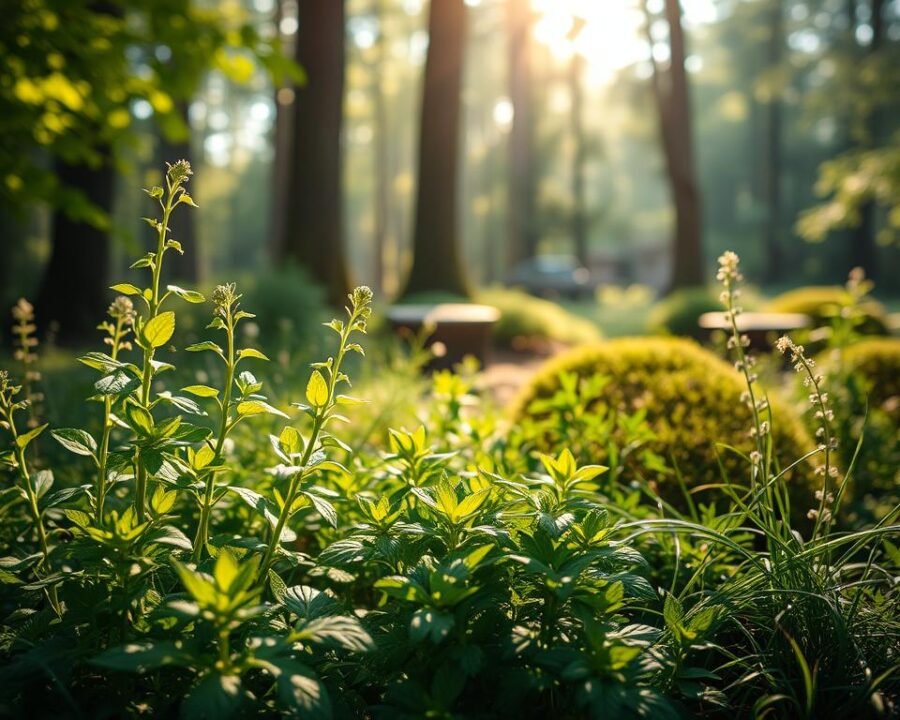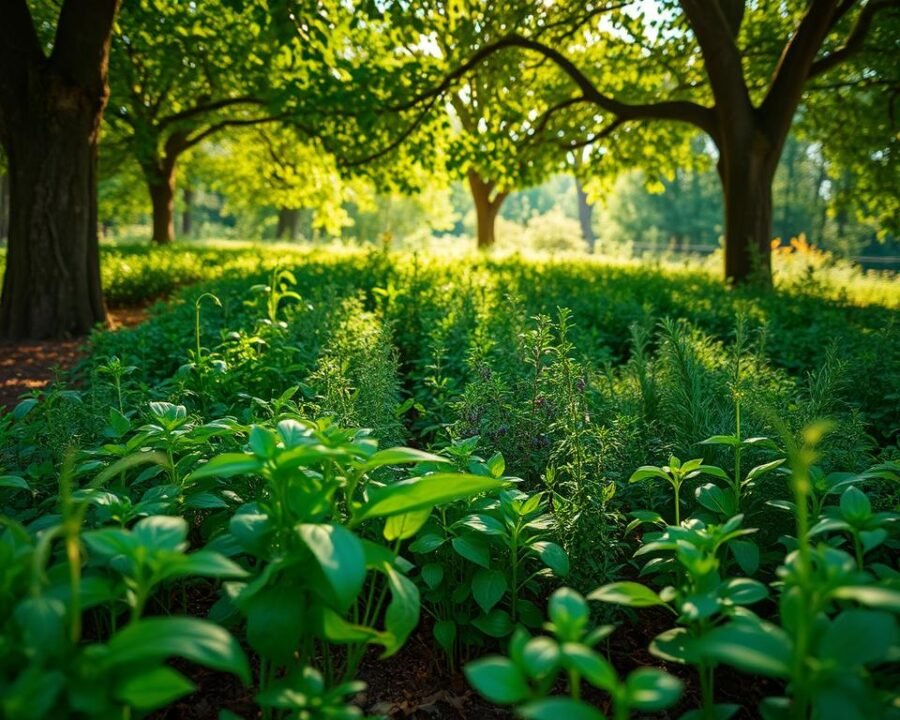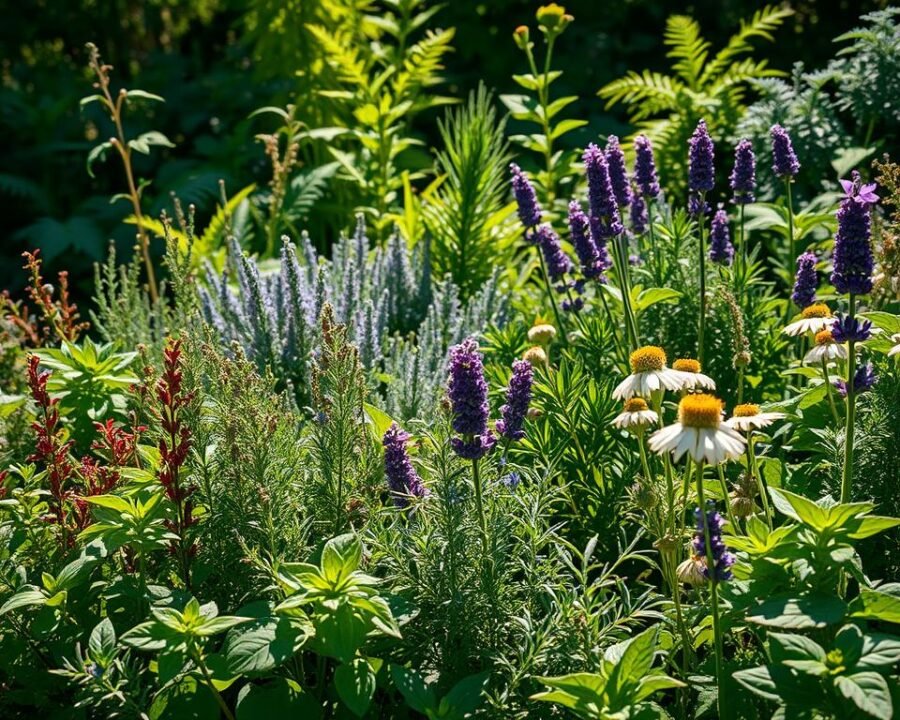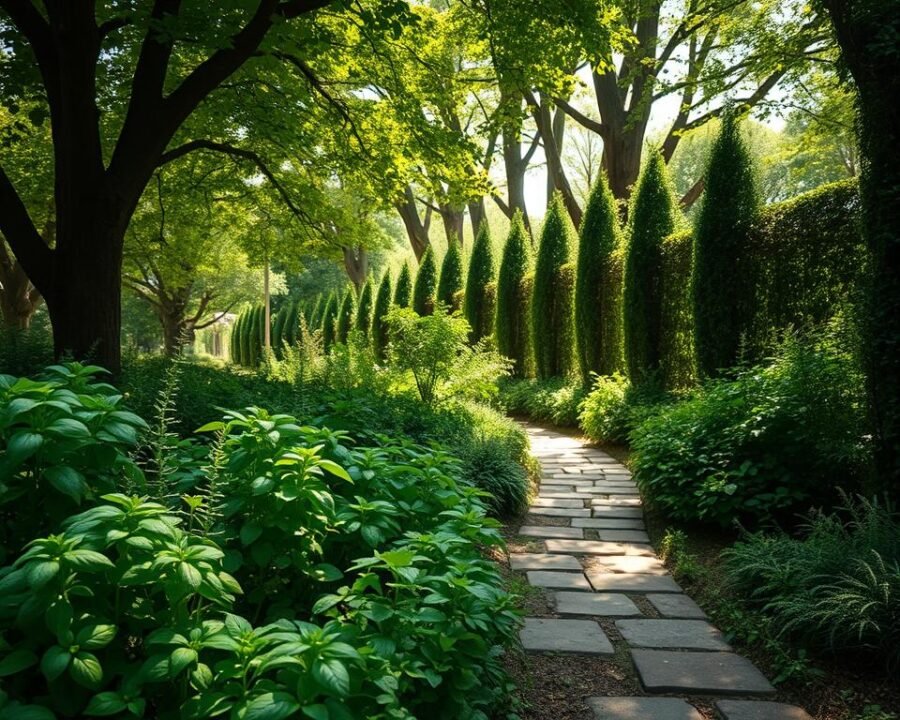Our Guide: how to grow herbs to plant in shade everyone is using
Ever dreamed of a lush, flavorful garden but lack full sunlight? You’re not alone. Many urban and suburban spaces have limited light, yet crave fresh, homegrown flavors. Shaded gardens offer a surprising advantage—cooler microclimates protect delicate leaves from scorching heat, extending their growing season.
Some of the most aromatic varieties, like parsley and cilantro, actually thrive in partial shade. These resilient plants adapt beautifully, producing vibrant flavors without constant sun exposure. Whether you have a balcony, patio, or a tucked-away corner, there’s a perfect herb waiting to flourish.
We’ve gathered expert insights, USDA zone tips, and practical solutions to help you succeed. From temperature ranges to container hacks, this guide unlocks the secrets of low-light gardening. Let’s explore six top-performing herbs that’ll transform your shaded space into a culinary oasis.
Key Takeaways
- Shaded gardens create ideal conditions for heat-sensitive herbs.
- Cooler temperatures extend the growing season for many varieties.
- Herbs like parsley and cilantro perform exceptionally well in partial shade.
- Urban and small-space gardens can thrive with the right plant choices.
- Proper container selection enhances growth in low-light areas.
Why Shade Gardens Deserve Flavorful Herbs
Shaded spaces often get overlooked, but they hold untapped potential for vibrant herb gardens. Many assume these areas can’t support robust growth, yet parsley patches in low-light corners prove otherwise. One gardener revived a wilted batch simply by moving it under a tree—its leaves doubled in size within weeks.
Shaded conditions mimic natural habitats where herbs evolved. Forest understories provide filtered sunlight, similar to dappled light under tree canopies. This environment protects delicate leaves from scorching while maintaining moisture levels.
Temperature plays a critical role too. Cilantro bolts quickly in heat, but shaded balconies keep temps between 35–65°F. This range delays flowering, extending harvests by weeks. Houston’s basement-level gardens showcase oregano and chives flourishing with just 2–3 hours of indirect light daily.
| Trait | Shade-Grown Herbs | Sun-Stressed Herbs |
|---|---|---|
| Flavor Intensity | More concentrated oils | Bitter or muted notes |
| Growth Rate | Steadier, prolonged | Rapid but short-lived |
| Water Needs | Less frequent | High evaporation |
Dappled light offers the best of both worlds—enough energy for photosynthesis without dehydration risks. Compare this to direct sun, which can scorch basil or wilt mint by midday. Shade-grown herbs often develop richer flavor profiles, as cooler temps slow oil evaporation.
Urban gardeners especially benefit. A Portland apartment’s north-facing patio produced lush lemon balm and thyme all summer. These plants adapted effortlessly, proving shade gardens are far from limiting.
6 Best Herbs That Thrive in Shade
Limited sunlight doesn’t mean sacrificing fresh flavors. Many aromatic varieties perform exceptionally well under tree canopies or on north-facing patios. Let’s explore six top picks that turn dim corners into culinary hotspots.

Lemon Balm: The Citrusy Healer
This bushy perennial reaches 24 inches with heart-shaped leaves packed with antiviral compounds. Dried leaves make soothing tea that eases stress—perfect for evening relaxation. For gardeners battling pests, plant near zucchini to deter squash bugs naturally.
Parsley: More Than Just a Garnish
Often overlooked, parsley boasts twice the vitamin C of oranges. Its flat or curly leaves star in chimichurri sauces and Mediterranean dishes. Unlike sun-dependent basil, it flourishes with just 3 hours of dappled light daily.
Mint: The Vigorous Spreaders
Peppermint and spearmint spread aggressively, making containers essential. Their cooling flavor enhances drinks and desserts. According to the Royal Horticultural Society, burying pots controls invasive roots while allowing lush growth in partial shade.
| Herb | Light Needs | Special Feature |
|---|---|---|
| Chives | 2-3 hours indirect light | Edible purple flowers |
| Cilantro | Morning sun only | Germinates in 5-7 days |
| Thyme | Filtered afternoon light | Drought-resistant once established |
Chives: Delicate Allium Charm
These slender stalks prefer loamy soil in containers. Snip them weekly to encourage continuous regrowth. Their mild onion flavor elevates salads and baked potatoes effortlessly.
Cilantro: Cool-Weather Favorite
Fast germination makes this herb ideal for kids’ gardening projects. Protect young plants from slugs with organic pellets. Regular harvesting prevents premature flowering.
Thyme: The Drought-Tolerant Wonder
Even in partial shade, thyme develops woody stems and tiny fragrant leaves. It withstands dry spells better than most herbs, needing water only when topsoil cracks appear.
How to Grow Herbs to Plant in Shade Everyone Is Using
Many aromatic plants prefer the gentle touch of filtered sunlight. The Apiaceae family, including parsley and cilantro, naturally thrives in cooler conditions. These varieties develop deeper flavors when shielded from intense afternoon rays.

Proper soil preparation makes all the difference. Mix 30% perlite into garden beds to prevent moisture buildup. Containers benefit from this amendment too, especially for thyme which resists drought once established.
Watering timing matters as much as frequency. Always irrigate in morning hours—this allows leaves to dry before nightfall. Damp foliage overnight invites fungal diseases that can devastate young plants.
| Task | Best Practice | Common Mistake |
|---|---|---|
| Light Management | Use reflective mulch | Overcrowding plants |
| Fertilization | 5-5-5 NPK monthly | Overusing nitrogen |
| Harvesting | Trim parsley stems regularly | Removing >1/3 foliage |
Boost ambient light with aluminum foil or white stone mulch. These simple tricks increase photosynthesis without scorching delicate leaves. Mint particularly responds well to these techniques, producing larger leaves.
For nutrition, balanced 5-5-5 formulas work better than fish emulsions in low-light conditions. Slow-release fertilizers prevent sudden growth spurts that weaken plants. Apply every 4-6 weeks during active growing seasons.
Pests love shady spots too. Neem oil solutions control slugs and snails effectively. Spray every 10-14 days, focusing on soil surfaces where these critters hide.
Winter protection extends your harvest. Mulch parsley crowns with straw before frost hits. Thyme survives cold snaps better when water is reduced gradually in autumn.
Propagation methods vary by variety:
- Mint: Stem cuttings root fastest in moisture-retentive mix
- Cilantro: Direct sowing yields strongest plants
- Chives: Division every 3 years maintains vigor
These approaches help herbs grow vigorously even with limited sunshine. Observing plant responses guides adjustments for your specific microclimate.
Designing Your Lush Shade Herb Garden
Transform dim corners into thriving green spaces with smart design choices. The right layout enhances air circulation and light exposure for healthy plants. We recommend assessing your space first—note where tree canopies filter sunlight throughout the day.
Container Gardening Solutions
Mint’s aggressive roots prove why container gardening works best for some varieties. Unglazed terra cotta pots allow soil to breathe, while fabric grow bags prevent circling roots. Both options suit shaded patios beautifully.
Drainage matters most in low-light conditions. Try these proven methods:
- Elevate pots with feet to avoid waterlogged soil
- Add gravel layers beneath potting mix
- Use stackable planters for vertical growth
Bay laurel demonstrates how tall plants create visual interest. Place them behind low-growing thyme or oregano for layered beauty. This approach maximizes limited space efficiently.
Companion Planting Strategies
Oregano forms dense mats that suppress weeds naturally. Pair it with chives—their purple flowers attract pollinators while repelling pests. This companion planting combo benefits both plants.
Consider these symbiotic groupings:
- Lemon balm + parsley (enhances flavor intensity)
- Cilantro + thyme (deters harmful insects)
- Mint + cabbage (protects from moths)
Strategic companion planting creates micro-ecosystems. The right combinations improve soil health and reduce maintenance. Your shaded garden becomes more productive with thoughtful pairings.
Remember to rotate container positions seasonally. This ensures all plants receive equal light exposure over time. A well-planned shaded garden delivers abundant harvests with minimal effort.
Culinary and Medicinal Uses of Shade-Grown Herbs
Shaded gardens offer more than just beauty—they provide a powerhouse of flavor and healing. These versatile plants elevate everyday dishes while serving as natural remedies. Let’s explore their dual-purpose magic.

Flavor Boosters for Your Kitchen
Chive blossom vinegar adds a delicate onion note to salads. Simply steep fresh flowers in apple cider vinegar for two weeks. Strain and use within six months for peak flavor.
Fermented parsley paste creates an umami bomb. Blend chopped leaves with 2% salt, then ferment for 14 days. This condiment enhances soups and roasted vegetables.
| Preservation Method | Flavor Retention | Best For |
|---|---|---|
| Freeze-drying | 90% original taste | Mint, lemon balm |
| Air-drying | 70% original taste | Thyme, oregano |
| Oil infusion | 85% original taste | Garlic, rosemary |
Natural Remedies from Your Garden
Lemon balm’s antiviral leaves combat cold sores effectively. Crush fresh foliage and apply directly to affected areas. Studies show it reduces healing time by 40%.
Mint tea soothes digestive discomfort. Steep 10 fresh leaves in hot water for five minutes. Drink after meals to ease bloating—a tradition dating back to ancient Greece.
Chives support heart health with their high allicin content. Regular consumption may lower blood pressure. Add raw stems to omelets or salads for maximum medicinal benefits.
For more medicinal herbs that thrive in low light, explore our guide on shade-tolerant healing plants. Discover how raspberry leaf supports women’s health and how valerian promotes restful sleep.
Conclusion: Your Path to a Thriving Shade Herb Garden
Your journey begins with simple steps. Track progress using our 30-day checklist—water schedules, light adjustments, and early pest checks set the foundation. Share cuttings at local plant swaps to expand your collection while connecting with fellow gardeners.
Seasonal care keeps plants vigorous. Mark calendars for autumn pruning and spring divisions. These routines ensure continuous harvests year after year. Even the shadiest nook can become a fragrant oasis with the right approach.
We challenge you to start three varieties from seed this month. Download our growth tracker to celebrate milestones. Imagine stepping outside to snip fresh chives for dinner or brewing calming lemon balm tea—all from your own lush corner.
Ready to transform overlooked spaces? Grab your gloves and let’s create something extraordinary together. The perfect blend of flavor and foliage awaits in your shade garden.







